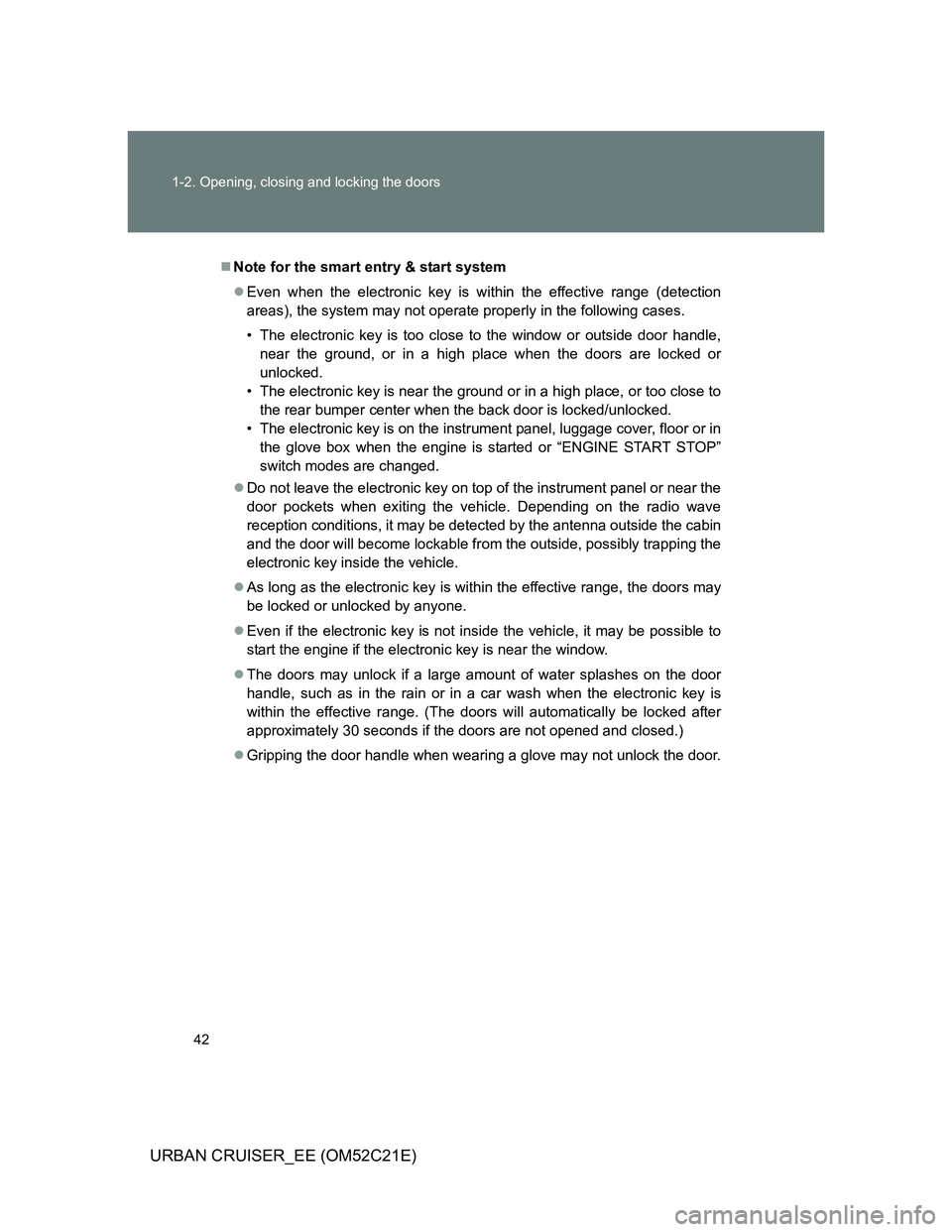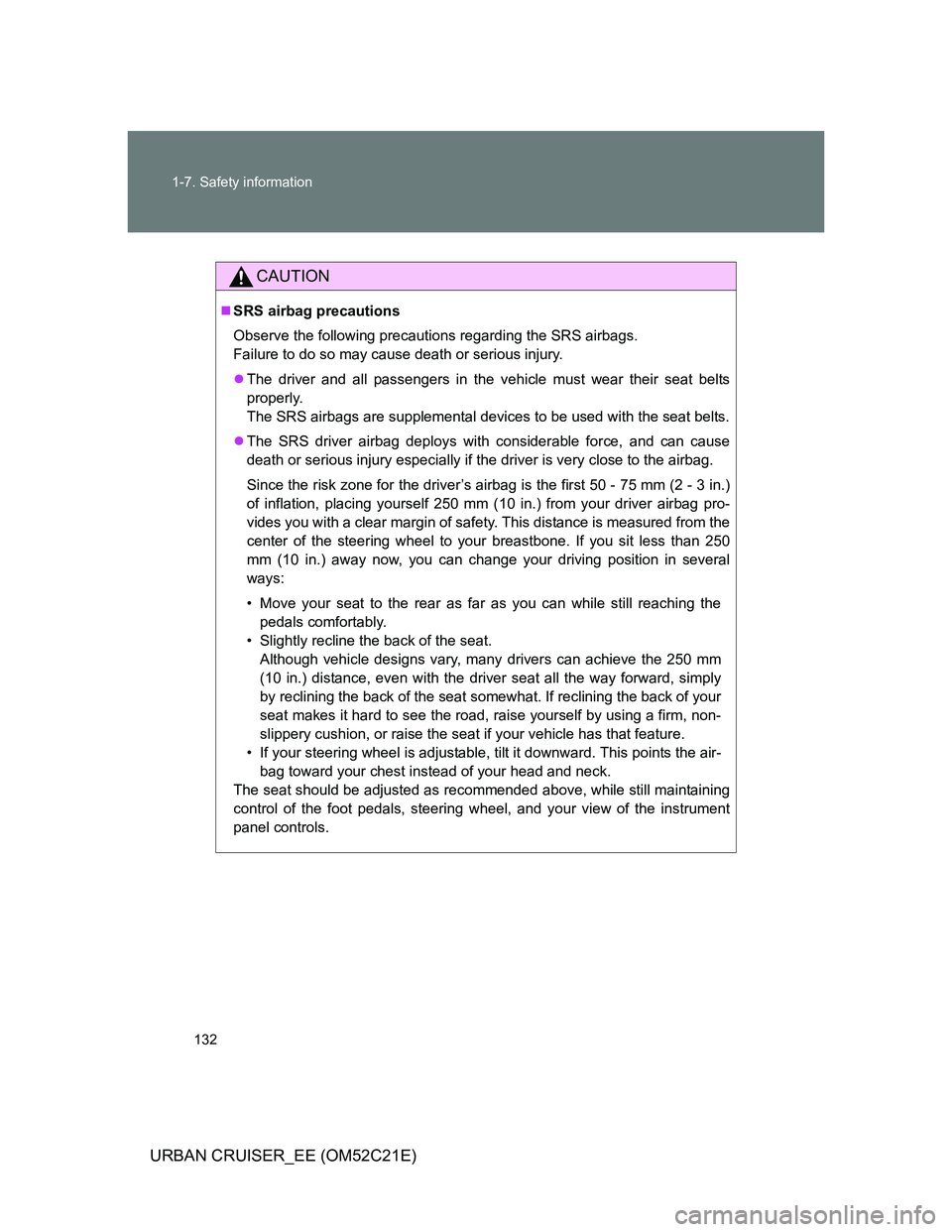Page 14 of 532
14
URBAN CRUISER_EE (OM52C21E)
Pictorial indexInstrument panel
(left-hand drive vehicles)
Headlight switch
Turn signal lever
Fog light switch
P. 201
P. 187
P. 205
Tilt and telescopic steering
lock release lever
P. 93
Windshield wipers and
washer switch
Rear window wiper and
washer switch
P. 207
P. 209
Fuel filler door opener P. 103
Gauges and meters
Multi-information display P. 190
P. 196
Bottle holder
P. 326
Audio system
Navigation system
*
P. 264
SRS knee airbag P. 124
Page 16 of 532
16
URBAN CRUISER_EE (OM52C21E)
B
Pictorial indexInstrument panel
(left-hand drive vehicles)
Telephone switch
Talk switch
P. 299
P. 299
Engine (ignition) switch (vehicles
with smart entry & start system)
P. 179
Engine (ignition) switch (vehicles
without smart entry & start system)
P. 175
Audio remote control
switches
P. 289
Page 22 of 532
22
URBAN CRUISER_EE (OM52C21E)
Headlight switch
Turn signal lever
Fog light switch
P. 201
P. 187
P. 205
Gauges and meters
Multi-information display P. 190
P. 196
Audio system
Navigation system
*
P. 264
Pictorial indexInstrument panel
(right-hand drive vehicles)
Windshield wipers and
washer switch
Rear window wiper and
washer switch
P. 207
P. 209
Bottle holder
P. 326
Fuel filler door opener P. 103
SRS knee airbag P. 124
Tilt and telescopic steering
lock release lever
P. 93
Page 24 of 532
24
URBAN CRUISER_EE (OM52C21E)
B
Pictorial indexInstrument panel
(right-hand drive vehicles)
Telephone switch
Talk switch
P. 299
P. 299
Engine (ignition) switch (vehicles
without smart entry & start system)
P. 175
Engine (ignition) switch (vehicles
with smart entry & start system)
P. 179
Audio remote control
switches
P. 289
Page 42 of 532

42 1-2. Opening, closing and locking the doors
URBAN CRUISER_EE (OM52C21E)
Note for the smart entry & start system
Even when the electronic key is within the effective range (detection
areas), the system may not operate properly in the following cases.
• The electronic key is too close to the window or outside door handle,
near the ground, or in a high place when the doors are locked or
unlocked.
• The electronic key is near the ground or in a high place, or too close to
the rear bumper center when the back door is locked/unlocked.
• The electronic key is on the instrument panel, luggage cover, floor or in
the glove box when the engine is started or “ENGINE START STOP”
switch modes are changed.
Do not leave the electronic key on top of the instrument panel or near the
door pockets when exiting the vehicle. Depending on the radio wave
reception conditions, it may be detected by the antenna outside the cabin
and the door will become lockable from the outside, possibly trapping the
electronic key inside the vehicle.
As long as the electronic key is within the effective range, the doors may
be locked or unlocked by anyone.
Even if the electronic key is not inside the vehicle, it may be possible to
start the engine if the electronic key is near the window.
The doors may unlock if a large amount of water splashes on the door
handle, such as in the rain or in a car wash when the electronic key is
within the effective range. (The doors will automatically be locked after
approximately 30 seconds if the doors are not opened and closed.)
Gripping the door handle when wearing a glove may not unlock the door.
Page 131 of 532
131 1-7. Safety information
1
Before driving
URBAN CRUISER_EE (OM52C21E)
The pad section of the steering wheel,
dashboard near the front passenger air-
bag or lower portion of the instrument
panel is scratched, cracked, or other-
wise damaged.
The surface of the seats with the side
airbag is scratched, cracked or other-
wise damaged.
The portion of the front, center and rear
pillar garnish, or roof interior containing
the curtain shield airbags inside is
scratched, cracked or otherwise dam-
aged.
Page 132 of 532

132 1-7. Safety information
URBAN CRUISER_EE (OM52C21E)
CAUTION
SRS airbag precautions
Observe the following precautions regarding the SRS airbags.
Failure to do so may cause death or serious injury.
The driver and all passengers in the vehicle must wear their seat belts
properly.
The SRS airbags are supplemental devices to be used with the seat belts.
The SRS driver airbag deploys with considerable force, and can cause
death or serious injury especially if the driver is very close to the airbag.
Since the risk zone for the driver’s airbag is the first 50 - 75 mm (2 - 3 in.)
of inflation, placing yourself 250 mm (10 in.) from your driver airbag pro-
vides you with a clear margin of safety. This distance is measured from the
center of the steering wheel to your breastbone. If you sit less than 250
mm (10 in.) away now, you can change your driving position in several
ways:
• Move your seat to the rear as far as you can while still reaching the
pedals comfortably.
• Slightly recline the back of the seat.
Although vehicle designs vary, many drivers can achieve the 250 mm
(10 in.) distance, even with the driver seat all the way forward, simply
by reclining the back of the seat somewhat. If reclining the back of your
seat makes it hard to see the road, raise yourself by using a firm, non-
slippery cushion, or raise the seat if your vehicle has that feature.
• If your steering wheel is adjustable, tilt it downward. This points the air-
bag toward your chest instead of your head and neck.
The seat should be adjusted as recommended above, while still maintaining
control of the foot pedals, steering wheel, and your view of the instrument
panel controls.
Page 134 of 532
134 1-7. Safety information
URBAN CRUISER_EE (OM52C21E)
CAUTION
SRS airbag precautions
Do not lean against the door, the roof
side rail or the front, side and rear pil-
lars.
Do not allow anyone to kneel on the
passenger seats toward the door or put
their head or hands outside the vehicle.
Do not attach anything to or lean any-
thing against areas such as the dash-
board, steering wheel pad or lower
portion of the instrument panel.
These items can become projectiles
when SRS driver, front passenger and
knee airbags deploy.